8 Types of Woodpeckers in Missouri (With Pictures)
Woodpeckers in Missouri have special features that help them live in trees. They have zygodactyl feet, which means two toes point forward and two backward. This lets them cling to trees easily. They also have long, barbed tongues that help them catch insects and gather sap.
Woodpecker Species Found in Missouri
- Red-bellied Woodpecker
- Red-headed Woodpecker
- Pileated Woodpecker
- Downy Woodpecker
- Hairy Woodpecker
- Lewis’s Woodpecker
- Northern Flicker
- Yellow-bellied Sapsucker
1. Red-bellied Woodpecker
- Scientific name – Melanerpes carolinus
- Lifespan – 12 years (maximum recorded)
- Size – (24 cm)
- Weight – (73.5 g)
- Wingspan – (42 cm)
The Red-bellied Woodpecker (Melanerpes carolinus) is a medium-sized bird found often in Missouri. It stands out with its red crown and nape, a buffy-white belly, and a black and white back. The male has more red on his head than the female, who has a small red patch on her nape.

Habitat and Nesting
This bird lives in the eastern United States, in woodlands, forests, and even suburban areas with many deciduous trees. They make their nests in cavities, often in dead branches or on human-made fence posts. The same pair comes back to the same spot every year but digs a new hole for the nest.
The female lays 2-6 eggs on the old wood chips. They can have up to three broods in a year.
Diet and Behavior
The Red-bellied Woodpecker eats mostly insects, spiders, and other small animals. But, it also eats plants like pine cones, nuts, and fruits, especially in fall and winter. It loves to visit bird feeders, especially for suet.
This bird is known for its unique, high-pitched “churr” or “kwirr” call.
2. Red-headed Woodpecker
- Scientific name – Melanerpes erythrocephalus
- Lifespan – 9 years (average) 12 years (maximum recorded)
- Size – (19-23 cm)
- Weight – (56-91 g)
- Wingspan – (42 cm)
The Red-headed Woodpecker (Melanerpes erythrocephalus) is a beautiful bird in Missouri. It’s known for its bright red head, white belly, and black and white wings. This bird is medium-sized, about 9.25 inches long with a wingspan of 17 inches.
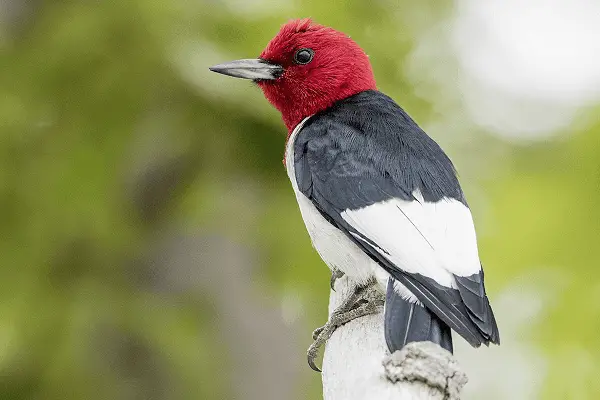
This bird stands out with its bright red head, neck, and upper chest. It also has a white belly and a black back with big white wing patches. These patches help tell it apart from other birds.
The red-headed woodpecker’s behavior is interesting. It makes a harsh, shrill “tchur” call. These birds live in many places like forests, parks, and even farmland. They need places to nest.
They make their nests in dead trees or buildings. They often use the same nest every year, which is rare for woodpeckers. They eat fruits, seeds, and insects, playing a big role in their ecosystems.
Red-headed woodpeckers are loved for their looks and important role in nature. Knowing how to spot them, where they live, and what they eat helps us protect them.
3. Pileated Woodpecker
- Scientific name – Dryocopus pileatus
- Lifespan – 12 years (maximum recorded)
- Size – (17,5 in)
- Weight – (300 g)
- Wingspan – (70.5 cm)
The pileated woodpecker (Dryocopus pileatus) is a big bird in Missouri and one of the largest in North America. It stands out with its large size, black body, and red crest. The male has a red stripe on his cheek, while the female has a black forehead.
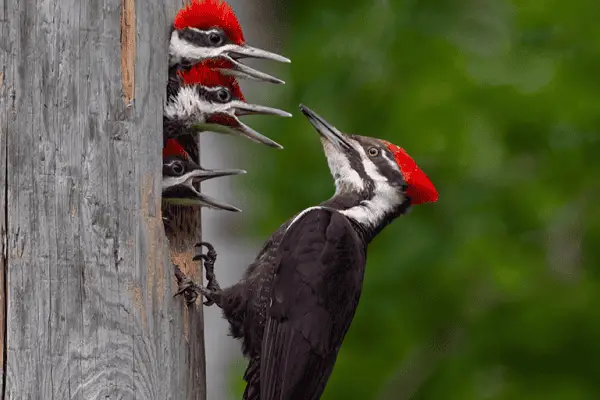
This bird is famous for its loud calls, like a kuk-kuk-kuk-kuk sound, echoing through the woods.
Range and Habitat Preferences
These woodpeckers live in forests with both deciduous and coniferous trees. They like mature woodlands and young forests with lots of dead trees. They also visit suburban areas with trees. They nest in large dead trees, making their own holes.
Feeding Habits and Food Sources
Their main food is carpenter ants, which they find by drumming on trees. They also eat other insects, fruits, nuts, and sometimes visit bird feeders for suet and seeds.
4. Downy Woodpecker
- Scientific name – Dryobates pubescens
- Lifespan – 2 years (average) 11 years (maximum recorded)
- Size – (16 cm)
- Weight – (0.9 oz)
- Wingspan – (28 cm)
The downy woodpecker (Dryobates pubescens) lives in the United States and Southern Canada. It’s known for its black-and-white look. It also has a short beak, which is rare for a woodpecker.

Vocalizations and Calls
The whiny call of the downy woodpecker sounds like a series of high-pitched sounds that get softer. It sounds a bit like the hairy woodpecker’s call but isn’t the same pitch. Downy woodpeckers also make a sharp “pik” sound, which is higher than the hairy’s call.
If you like birdwatching or just enjoy watching birds, the downy woodpecker is fun to see. Its fun behavior and unique sounds make it a great bird to spot.
5. Hairy Woodpecker
- Scientific name – Leuconotopicus villosus
- Lifespan – 15 years (maximum recorded)
- Size – (22 cm)
- Weight – (67 g)
- Wingspan – (37 cm)
The Hairy Woodpecker (Dryobates villosus) is a medium-sized bird with black and white feathers. It lives in Missouri’s timbered areas, especially where dead trees are common. These birds find plenty of food in such places.
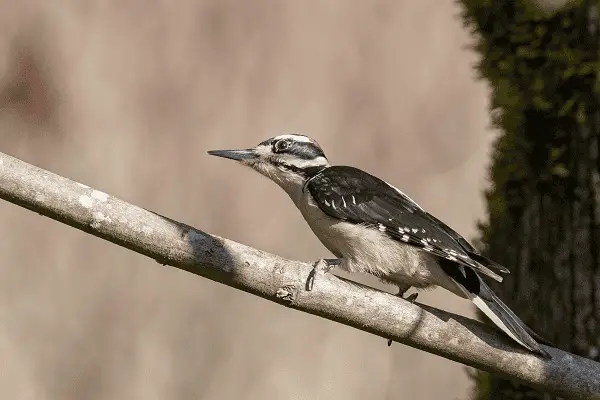
Physical Description and Sexual Dimorphism
Hairy Woodpeckers are about 9 to 10 inches long and weigh 2 to 3 ounces. They stand out with their black-and-white look, having a white belly and black wings. Males have a small red spot on their head, but females do not.
Differentiating from Downy Woodpecker
Telling Hairy Woodpeckers apart from Downy Woodpeckers can be hard. But, there are some clear differences:
- Size: Hairy Woodpeckers are bigger, measuring 9-11 inches, while Downy Woodpeckers are smaller, at 6-7 inches.
- Bill size: Hairy Woodpeckers have a longer bill, nearly as long as their head, while Downy Woodpeckers have a much smaller bill, less than half the length of their head.
- Tail feathers: The outer tail feathers of Hairy Woodpeckers are all white, but Downy Woodpeckers have spotted outer tail feathers.
By noticing these differences, you can easily tell a Hairy Woodpecker from a Downy Woodpecker.
6. Lewis’s Woodpecker
- Scientific name – Melanerpes lewis
- Lifespan – 10 years (maximum recorded)
- Size – 10.6 in
- Weight – 4 oz
- Wingspan – 19.9 in
The Lewis’s Woodpecker (Melanerpes lewis) is found mainly in the western United States and southwestern Canada. It lives in states like California, Oregon, Colorado, Arizona, New Mexico, and parts of Utah all year. But, it moves a bit south in winter and north in summer.
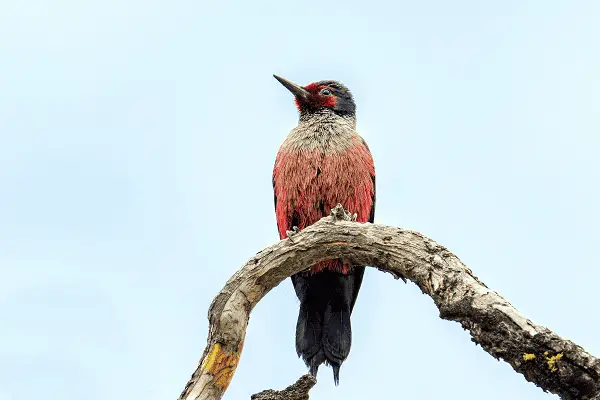
Unique Foraging Behavior
The Lewis’s Woodpecker is different from other woodpeckers because it doesn’t just peck on trees for food. It’s great at catching insects in mid-air. It also eats fruits, seeds, and nuts, storing some in tree crevices for later.
| Characteristic | Description |
|---|---|
| Lewis’s Woodpecker Size | Larger than an Acorn Woodpecker but smaller than a Northern Flicker |
| Nesting Habitat | Cavities in dead and decaying trees in oak woodlands, open ponderosa pine forests, and woodlands near streams |
| Foraging Behavior | Catches insects on the wing, resembling a crow in flight |
| Preferred Habitats | Open ponderosa pine forests, woodlands near streams, oak woodlands, burned forests, orchards, agricultural areas with scattered trees, and pinyon-juniper woodlands |
| Population Decline | Noted 72% decline between 1970 and 2014 due to habitat destruction |
| Nesting Habits | Females typically lay 6-8 eggs per breeding season, with an incubation period of around 12 days and fledglings leaving the nest in approximately a month |
Learning about Lewis’s Woodpecker’s range, migration patterns, and unique foraging behavior helps us value woodpeckers in Missouri. It also shows why we need to protect their homes.
7. Northern Flicker
- Scientific name – Colaptes auratus
- Lifespan – 9 years (maximum recorded)
- Size – (32 cm)
- Weight – (126.5 g)
- Wingspan – (48 cm)
The Northern Flicker has two main types: the Yellow-shafted and the Red-shafted Flicker. Both have a light underside and dark wings with big black spots. But, their tails and wing feathers show a key difference. Yellow-shafted Flickers have bright yellow feathers, while Red-shafted ones have orangey-red feathers.

Ground Foraging Habits
Northern Flickers are special because they forage on the ground as much as in trees. They love to eat ants, which are a big part of their diet. This ground-foraging makes them different from other woodpeckers, who usually stick to tree trunks and branches.
The Northern Flicker is about 12 to 14 inches long and has a wingspan of 12 to 16 inches. Adults weigh less than six ounces and can live up to nine years. They breed from early spring to mid-summer, laying three to 12 eggs. The eggs hatch in 11 to 16 days, and the young ones can fly in three weeks to a month.
Northern Flickers live in wooded areas with dead trees, open spaces, and even near homes. In Missouri, eight woodpecker species are found, with seven being common.
Check Our Previous Articles:
8. Yellow-bellied Sapsucker
- Scientific name – Sphyrapicus varius
- Lifespan – 7 years (maximum recorded)
- Size – (20 cm)
- Weight – (50.3 g)
- Wingspan – (37 cm)
While birdwatching in Missouri, you might see a Yellow-bellied Sapsucker. These woodpeckers migrate from southern Missouri to the northern parts of the state. They stand out with their black-and-white look, red crown, and white patches on their shoulders.
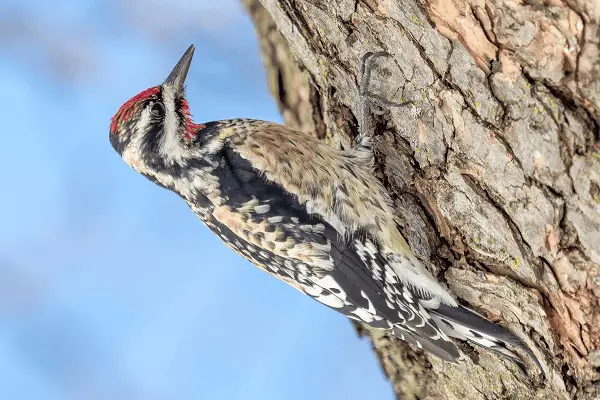
Their main food is tree sap. They drill holes in trees like maple and hickory to get it. This not only gives them food but also brings insects for them to eat. It takes a lot of sap to make just one gallon of maple syrup, showing how much these birds can produce.
Yellow-bellied Sapsuckers are not common in Missouri but their sap-drilling signs are easy to spot. They often hang out with birds like Purple Finches and Carolina Chickadees. These birds enjoy the sap wells the Sapsuckers make. Listen for their unique “meow” call in Missouri’s forests and woodlands.
Frequently Asked Questions:
Q1. How many types of woodpeckers are there in Missouri?
There are 7 types of woodpeckers in Missouri.
Q2. How big are pileated woodpeckers in Missouri?
Pileated woodpeckers in Missouri are about 16 to 19 inches long with a wingspan of up to 30 inches.
Q3. Where are woodpeckers most common?
Woodpeckers are most common in wooded areas with plenty of trees, such as forests and suburban areas.
Q4. What kind of bird is grey with a red head in Missouri?
The bird you’re describing is likely a Red-bellied Woodpecker, which has a grey body and a red cap on its head.







